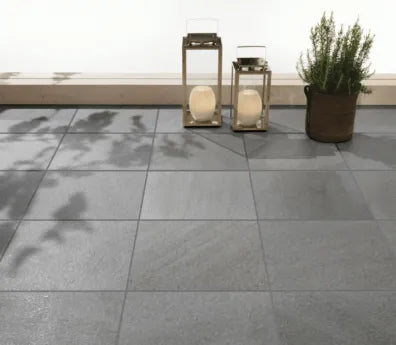
How to Lay Outdoor Tile on Concrete
Share
Backyard parties and family get-togethers are a safe, fun way to spend time with loved ones. With this trend, outdoor tile is a popular choice for creating a user-friendly, stable floor. Homeowners often choose porcelain tile for outdoor installation over an existing concrete pad.
Looking for outdoor tile? Visit one of our 6 NJ locations:
Standard Tile In Jersey City NJ
How to Select Outdoor Tile
There are a couple aspects to consider when selecting outdoor tile, especially in the Northeast. You always have to consider the weather. The tile you select has to be able to withstand extreme colds and extreme heats.
You also want to make sure that the material you select has a low absorption rate. You can always check with the manufacturers to make sure that the tile you’re choosing is rated for exterior use.
Additionally, when choosing the tile itself you want to make sure it has a matte or textured surface so that you’re not slipping and falling down outside from wet or frozen tile. Porcelain tile checks all of these boxes, and for that reason it is the best choice when it comes to selecting tile for your outdoor area.
How To Install Outdoor Tile Over Concrete
Many homeowners already have a concrete patio installed in their backyard. As it is far easier to use the concrete than to remove it, installing the tile over the concrete is the best option. Carefully examine your existing pad to determine if it will work well with tile laying.
- Water must drain properly from the concrete patio.
- The area should be completely level.
- Cracks must be stable and at the same level. If the cracks are widening, it is best not to use the concrete you have.
- The slab will need to be cleaned thoroughly with a high psi pressure washer.
- Muriatic acid is also good for cleaning and roughing concrete.
- Fill any cracks with caulk, and holes should be filled with latex or vinyl blend that you can purchase at a hardware store.
Working On the Project
First, arrange the tiles in the way you desire to have them placed, allowing space for the grout lines. Next, make a mixture of thin-set mortar, and apply it with a trowel. Start with a thick layer and spread it on with the flat side of the trowel. Then, pull the comb side of the trowel through the mortar.

Place the tile on the concrete surface with the mortar. Continue through the entire area, and use spacers between all joints of the tile, ensuring that all of the spaces are uniform for the grout lines. After all of the tile is laid and thin-set mortar is cured, work the grout into the lines. Use a damp sponge to wipe away excess grout, rinsing the sponge frequently.
As far as the installation materials go on an outdoor project, you want to be sure that you use a quality polymer modified thin-set to lay your tile. An excellent product for exterior use would be our Laticrete 254 Platinum thin-set, which is rated for exterior use. It will not be affected by the freeze-thaw cycle that happens here in the Northeast, so it is recommended to use that for your thin-set or a similar product. For the grout, a really good exterior grout is the Laticrete Permacolor grout. Basically, it is a non-traditional, cement-based grout, great for outdoors, and also can minimize the occurrence of efflorescence, which is discoloration of your grout.
Takeaways
- Choose the correct tile (porcelain is generally best)
- Prepare the area prior to laying the tile. Preparation is key to the success of this project.
- Lay tile in desired design
- Grout with exterior grout, let set and enjoy!
With over 100 years of experience, Standard Tile is the go-to place for all your tile or paver installation needs. Call or visit our showroom today to experience the Standard Tile difference: 1-800-648-TILE.